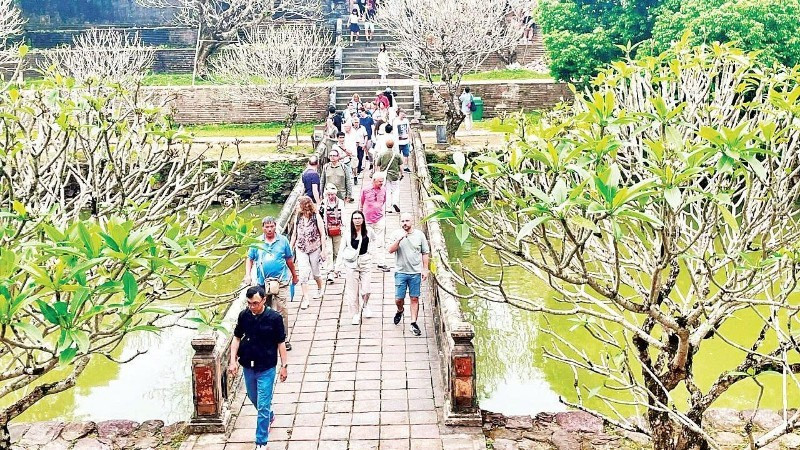Turning tourism into inspirational economic sector
With its impressive growth momentum, tourism has been recognised as one of the top 10 highlights in Viet Nam's socio-economic landscape during the first half of this year.

To further assert its role as an economic driver, Vietnamese tourism must seize opportunities, leverage its strengths, and implement a well-crafted promotion supported by a diverse, experience-rich product system.
Impressive figures
According to the General Statistics Office (Ministry of Finance), in the first six months of 2025, Viet Nam welcomed nearly 10.7 million international visitors, up 20.7% year-on-year, reaching 48.6% of the 2025 target (22–23 million arrivals). At the same time, 77.5 million domestic travellers were served, up 8.5% year-on-year, fulfilling 64.5% of the 2025 plan (120–130 million arrivals). Total tourism revenue was estimated at 518 trillion VND, meeting 52.8% of the annual target (980 trillion – 1.05 quadrillion VND).
These are remarkable figures, especially as many countries in the region continue to struggle to recover. In fact, according to UN Tourism's report for the first quarter of 2025, Viet Nam led the Asia-Pacific region in international visitor growth (up 30% compared to the first quarter of 2024) and ranked second in international tourism recovery (up 34% compared to the first quarter of 2019).
This not only reflects the strong breakthrough of Vietnamese tourism but also affirms Viet Nam’s growing appeal as a regional and global travel destination.
A significant contributor to this positive growth is the effort to develop tourism products. Recognising product innovation as the "key" to encouraging longer stays and higher spending, many travel businesses have partnered with localities to revamp and diversify offerings, capitalising on each destination’s competitive advantages while highlighting heritage and cultural identity.
Examples include the “Enjoy Da Nang” Festival; the “Ocean Meets Forest” experience (Phu Quoc); “Former Battlefield – New Experience” (Tuyen Quang); the high-quality “Flamboyant Train” (Hai Phong); and especially a patriotic tourism product series launched on the April 30 – May 1 holiday, such as “From Mau Than to the Spring of Victory” and “Legends of the Special Force Heroes of Sac Forest– The Iron Land – Ho Chi Minh City”.
In parallel, promotional efforts have been a key focus of the tourism sector. Besides actively participating in major global tourism forums and fairs, many large-scale events have been vigorously promoted by local authorities and businesses, including the Vietnam International Travel Mart (VITM) Ha Noi, Ho Chi Minh City Tourism Festival, National Tourism Year – Hue 2025, and the Da Nang International Fireworks Festival.
Notably, the 2025 tourism stimulus programme “Viet Nam – Go for Love” launched by the Ministry of Culture, Sports and Tourism continues to receive strong support. The tourism industry has proactively embraced new trends, leveraging Industry 4.0 technologies to implement e-marketing campaigns, promote destinations, introduce products, and offer digital tourism guidance.
Identifying resources, redrawing tourism map
To enable Vietnamese tourism to make greater strides, experts believe new driving forces are still needed. A candid assessment reveals that, while the tourism product system has become more diverse, it still fails to fully tap into existing potential, with low added value; promotional and marketing efforts also lack distinctive highlights and have yet to establish a truly outstanding national tourism brand.
As global travellers shift away from mass tourism towards seeking unique experiences, Viet Nam’s tourism sector must transform itself to win over tourists with a deeper communication strategy tied to distinctive, differentiated products.
Chairing the online conference on implementing key tourism tasks for the second half of 2025, Minister of Culture, Sports and Tourism Nguyen Van Hung stated that: in the context of the nationwide administrative space reorganisation and the newly operational two-tier local government model, to achieve the target of welcoming 22–23 million international visitors and 120–130 million domestic travellers, contributing to the 2025 GDP growth target of over 8% and double-digit growth in the coming period, a key priority now is to identify resources in order to "redraw the tourism map of Viet Nam". This "redrawing" does not mean disregarding what already exists, but rather approaching it with a fresh mindset to strengthen connectivity and capitalise on the advantages and development opportunities emerging from an expanded post-merger administrative space.
According to Minister Nguyen Van Hung, today's tourists do not merely seek sightseeing opportunities; they also desire rich experiences and emotional fulfilment during their journeys. Therefore, tourism must not only become a spearhead economic sector, but more importantly, an “inspirational” economic sector.
To achieve this, those working in the tourism industry must begin with small actions driven by great passion, creating appealing products rich in cultural identity and capable of inspiring visitors to return again and again.
Identifying ten key markets for Vietnamese tourism—namely the Republic of Korea, China, Japan, the United States, Australia, Europe, Southeast Asia, India, the Middle East, and Russia, the Minister emphasised the need to embrace the principle of "market-oriented and brand-driven" development. This involves building large-scale, in-depth promotional strategies with strong interconnectivity that resonate emotionally with tourists.
Sharing this view, Chairman of the Viet Nam Tourism Association Vu The Binh affirmed that tourism products are the core element determining competitiveness. It is therefore essential to develop unique and distinctive offerings based on cultural resources. To drive rapid and robust tourism development, it is necessary to align with the two pillars of "green transformation" and "digital transformation", while identifying promotion and marketing as central tasks in attracting tourists, combining modern and traditional methods and accelerating the establishment of Viet Nam’s tourism promotion offices abroad.
From the perspective of local tourism management, Director of the Ha Noi Department of Tourism Dang Huong Giang proposed that the Ministry of Culture, Sports and Tourism study and formulate an overarching action programme for tourism development in the coming period. This should focus on strategic directions, tasks, and solutions for provinces and cities in sectoral planning, encouraging investment in new and innovative products, driving digital transformation linked to building a smart tourism ecosystem, and improving workforce training.
Director General of the Viet Nam National Authority of Tourism Nguyen Trung Khanh noted that soon, the sector will restructure the tourism market, implement regional and inter-regional action plans, and promote cross-sector linkages within the tourism value chain to enhance competitiveness in line with green and sustainable development, under the motto of “placing visitor experience at the centre”. Additionally, continued innovation in both content and delivery methods is expected, along with a balanced mobilisation of state and social resources for promotion, aiming to solidify Viet Nam’s national tourism brand positioning.








